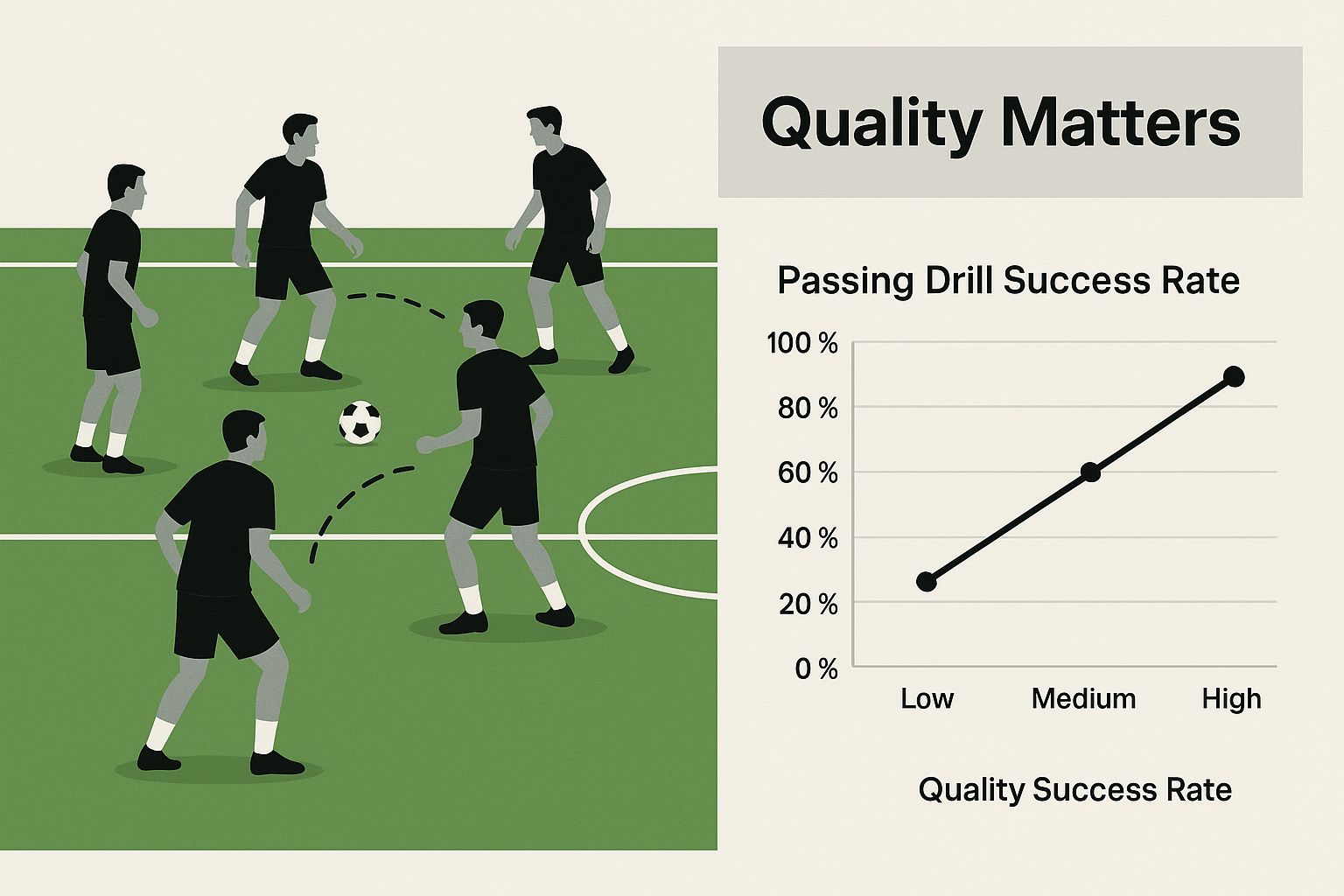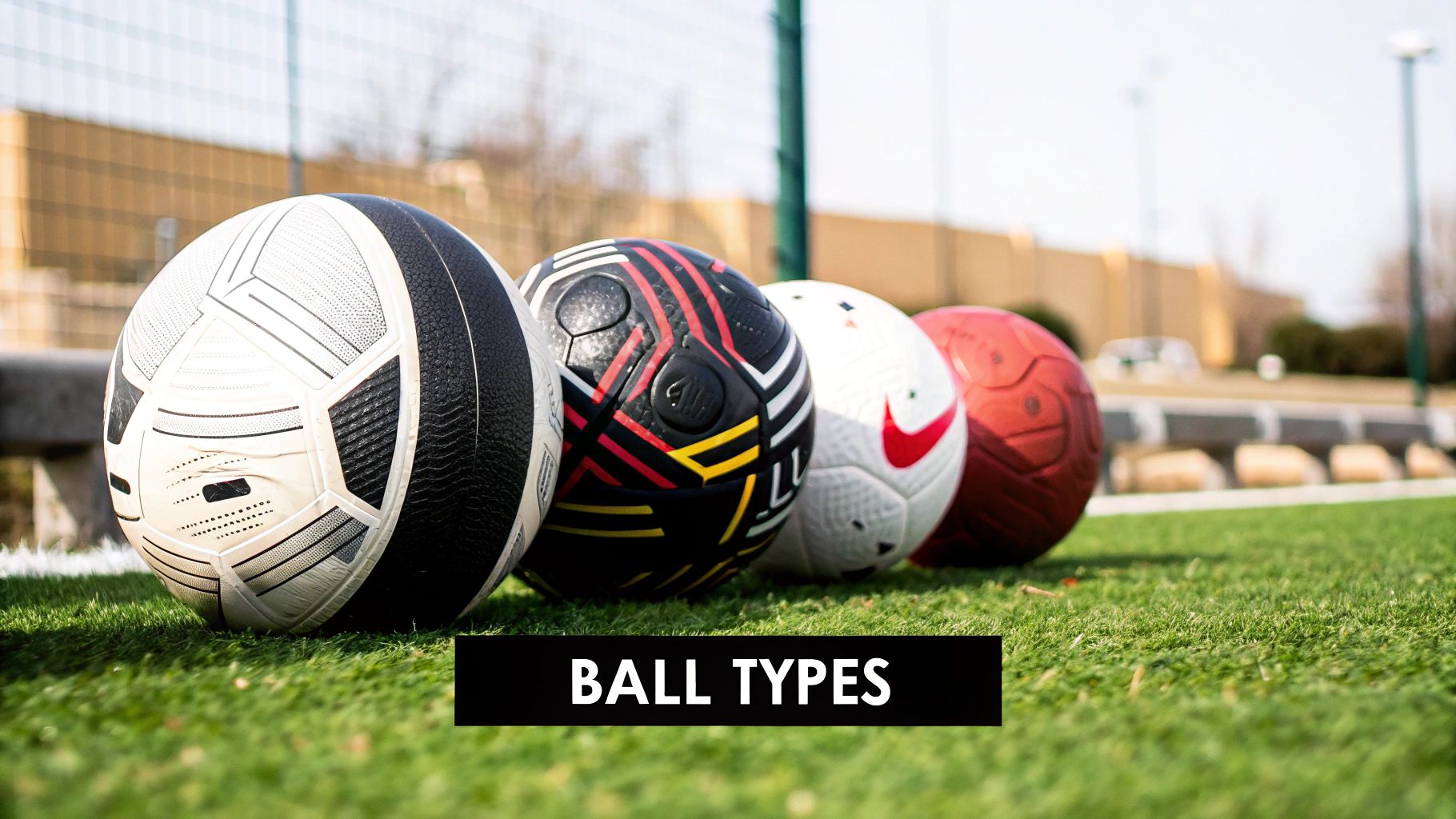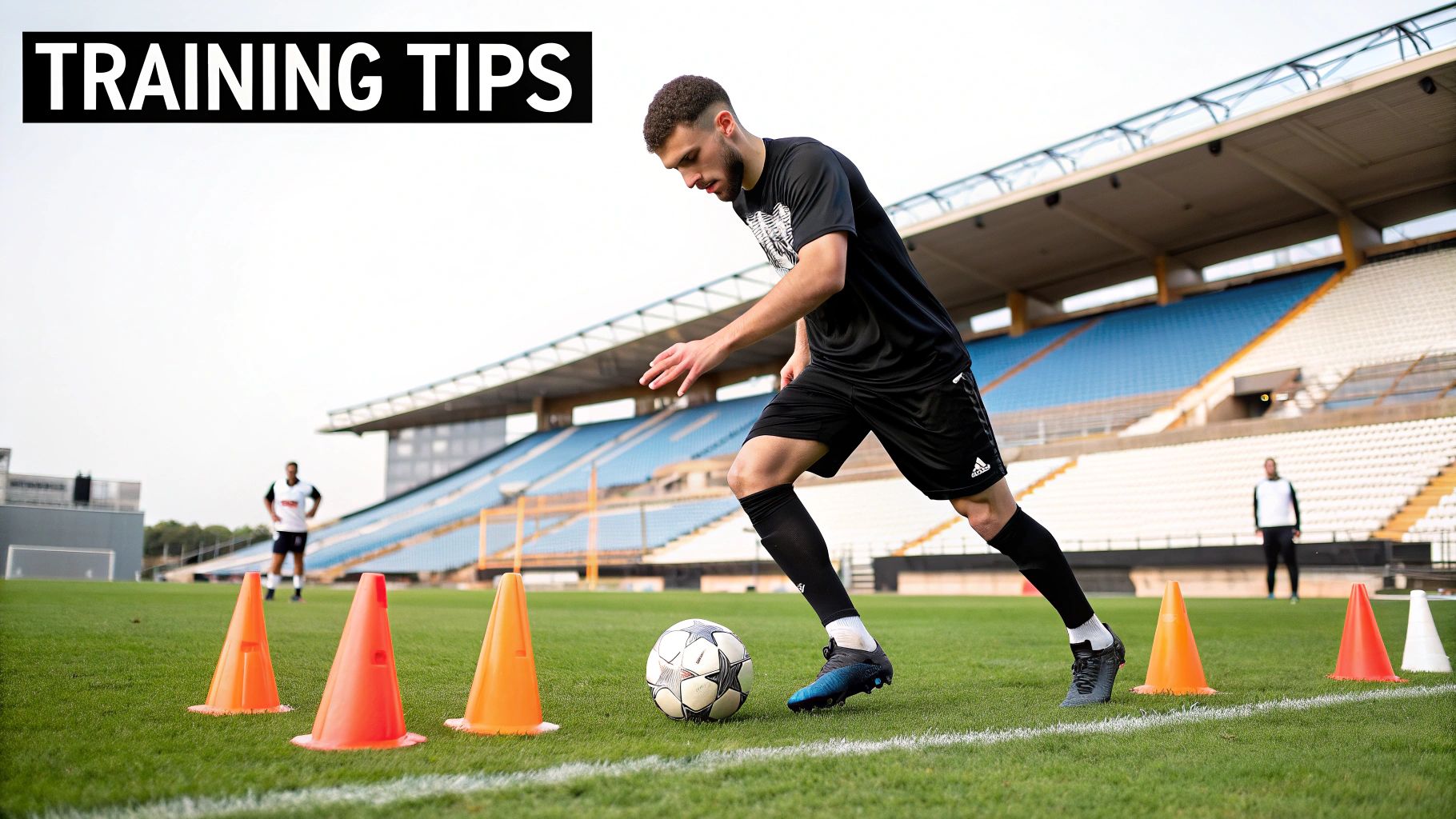It’s easy to think a football is just a football, but the one you use for training is arguably the most important piece of kit you own. A dedicated football training ball is your workhorse—it’s built for the relentless grind of practice in a way that pricier match balls simply aren't.
This guide will walk you through finding the perfect one for your needs.
Why a Quality Training Ball is a Smart Investment
Using the right ball is absolutely fundamental for developing a solid technique. While a top-end match ball feels amazing on game day, it’s not designed to take a beating through hundreds of drills, repetitive strikes, and rougher surfaces. That’s where training balls come in. They’re engineered specifically for this purpose, giving you a cost-effective tool without sacrificing the feel you need to improve.
Here in the UK, where football is a way of life, having the right gear from a young age sets the stage for future success. It's no surprise the UK football equipment market was valued at around USD 422.23 million and is expected to hit an estimated USD 516.21 million by 2034. Training balls are a massive part of that, because they’re essential for player development. You can discover more insights on the UK football market to see just how big the demand is.
This infographic shows just how vital consistent practice with the right ball is for building a player's foundations.

The key takeaway here is that quality isn’t about the price tag—it’s about picking the right tool for the job to get the most out of every session.
The Real-World Impact on Your Game
A good training ball helps you build the right kind of muscle memory. A ball that’s poorly made, or the wrong size, can teach you bad habits that are incredibly difficult to unlearn later on. When you use a consistent, reliable ball, every touch, pass, and shot feels predictable. That allows you to stop thinking about the ball and start focusing purely on your technique.
Just think about these key benefits:
- Built to Last: They’re made with robust materials like PVC or TPU, so they can handle everything from pristine grass to gritty astro-turf without falling apart.
- Smarter on the Wallet: Training balls are significantly more affordable than official match balls. This makes them perfect for individual players, schools, and clubs that need to buy in bulk.
- Feels Like the Real Deal: Many modern training balls mimic the features of their match-day counterparts, like thermal bonding, giving you a similar flight and feel for a fraction of the cost.
Investing in a quality training ball is a direct investment in your own improvement. It's the most-used piece of equipment in your kit bag, and choosing wisely pays dividends every single time you step onto the pitch.
Matching Ball Size to Player Age
Getting the ball size right is one of the most important—and often overlooked—parts of a player's development, especially for kids. Hand a youngster a ball that’s too big or heavy, and you’re accidentally teaching them bad habits. It can hurt their confidence and even raise the risk of injury.

Think about it from their perspective. A huge, heavy ball feels clumsy. It’s hard to get your foot around it, making it tough to learn the finer points of dribbling or passing. The right-sized ball, on the other hand, feels like an extension of their foot, allowing skills to develop naturally.
UK Football Training Ball Size Guide
In the UK, the FA has clear guidelines to make sure young players use equipment that fits their age and physical ability. It’s all about creating a safe and effective learning environment. This simple table breaks it down for you.
| Ball Size | Recommended Age Group (UK) | Typical Circumference (cm) | Primary Use |
|---|---|---|---|
| Size 3 | 6-9 Years (U7-U9) | 58-61 cm | Building basic skills and coordination for young children. |
| Size 4 | 10-14 Years (U10-U14) | 63.5-66 cm | Developing technique and control for junior players. |
| Size 5 | 14+ Years (U15+) | 68-70 cm | Standard training and matches for youth and adult football. |
This isn't just a casual suggestion; it's a fundamental part of good coaching that ensures players build skills on a solid, safe foundation. Let's look a little closer at what each size means in practice.
The Breakdown of Ball Sizes
-
Size 3: This is where the journey starts. Designed for the youngest players, usually between 6 and 9 years old (Under-7s to Under-9s), its smaller size and lower weight are perfect for little feet to build control without feeling overwhelmed.
-
Size 4: As players get a bit older and stronger, typically from 10 to 14 (Under-10s to Under-14s), they move up to a Size 4. This ball is a crucial stepping stone, bridging the gap between the junior and senior game.
-
Size 5: The standard, full-sized ball you see in the pro leagues. This is for everyone aged 14 and over. If you’re training for senior football, this is the one you need to master.
Using the right size ball isn't just a recommendation; it's a fundamental part of effective coaching and player safety. It allows for proper muscle development and ensures technical skills are built on a solid foundation.
If you’re looking specifically for a ball for older players, we’ve got a detailed guide on the training football Size 5 that covers everything you need to know.
A Look Under the Hood: Ball Materials and Construction
Ever wondered what actually makes a training ball tick? The materials and the way it’s put together are everything. They determine how the ball feels at your feet, how long it lasts, and how it behaves on different surfaces. When you're looking at product descriptions, you’ll see terms like PVC, TPU, and different stitching methods. Getting to grips with these is your secret weapon for picking a ball that won’t let you down.
This stuff matters more than ever. The global market for footballs is booming—it was valued at USD 5.4 billion and is expected to hit USD 7.2 billion by 2033. Training balls are a massive part of this, mainly because new materials have made them tougher and better to play with. You can read more about the growing football market to see where things are headed.
The Outer Casing: PVC vs. TPU
The outer layer, or casing, is what takes all the punishment. For training balls, you’ll mostly find two types: PVC and TPU. They’re built for different jobs.
-
PVC (Polyvinyl Chloride): Think of this as the tough, rugged option. PVC is seriously scuff-resistant, which makes it perfect for unforgiving surfaces like tarmac, concrete, or that worn-out 3G pitch at the local park. If your training involves a lot of street footy or hard-ground drills, a PVC ball is a smart, durable, and budget-friendly choice.
-
TPU (Thermoplastic Polyurethane): This is the good stuff. TPU gives you a much softer, more responsive touch—much closer to what you’d get from a pricey match ball. It’s ideal for grass pitches where touch, feel, and control are what you’re working on. It’s not quite as bulletproof as PVC on rough ground, but for pure performance in technical drills, TPU is king.
How It’s All Held Together: Stitching and Bonding
Just as important as the outer material is how the panels are joined. This affects the ball’s shape, how it handles water, and its overall lifespan.
Machine-stitched balls are the most common workhorses you'll find in any training bag. A machine sews the panels together, leaving visible seams. It’s a reliable and affordable way to make a football, which is why they’re the go-to for general practice sessions, clubs, and schools buying in bulk. Simple, effective, and gets the job done.
Then you have Thermal-Bonded balls. Here, the panels are fused together with heat, creating a virtually seamless surface. This has two brilliant advantages. First, it stops the ball from soaking up water, so it won’t turn into a heavy, waterlogged cannonball in classic UK weather. Second, the seamless design means it holds its shape perfectly and gives you a truer, more predictable flight through the air.
For a player who wants their training to feel as close to match day as possible, a thermal-bonded TPU ball is a fantastic investment. But for an all-round, dependable workhorse that offers great value and durability, you can’t go wrong with a machine-stitched PVC or TPU ball.
Key Features for Durability and Performance
A great football training ball has to do more than just look the part—it needs to stand up to week after week of drills, passes, and shots. What really separates a top-tier training ball from a cheap one isn't the flashy design, but the hidden components inside: the bladder and the lining.
Getting these right means the difference between a ball that performs consistently and one that goes flat or loses its shape after a few hard sessions.
Bladder Type Matters
Think of the bladder as the ball's engine. It's what holds the air and gives the ball its bounce and feel. The two you’ll come across are butyl and latex, and they serve very different purposes.
- Butyl Bladders: These are the workhorses. Their biggest advantage is fantastic air retention. A ball with a butyl bladder can stay properly inflated for weeks, making it the perfect low-maintenance choice for your training bag. Just grab it and go. The feel is a little firmer, which gives you a reliable, consistent response every time you strike it.
- Latex Bladders: You'll usually find latex bladders in more expensive match balls. They offer a much softer touch and a livelier, more responsive bounce. The trade-off? Latex is porous, so it loses air much faster. You'll likely need to pump it up before every single training session.
For most training scenarios, a butyl bladder is the way to go. It offers brilliant air retention, so your ball is always ready for action when you are. It’s the reliable choice you can count on.
The Unseen Support System
Sandwiched between the bladder and the outer cover are layers of polyester or cotton lining. This is the ball's skeleton. It provides strength, structure, and stops the ball from turning into an egg shape after a few hundred thumps against a wall.
Generally, the more layers of lining, the better the ball will hold its shape and perform predictably over time. A well-made ball with a solid lining delivers a true flight and a consistent bounce, session after session. This is especially important when you’re running drills. Pairing a quality ball with the right equipment is key; you can check out a great selection of football goals suitable for training right here. At the end of the day, you want a ball that feels the same on the hundredth kick as it did on the first.
Making Smart Purchases for Your Budget
Let's talk about value. For clubs, schools, and even families buying for the kids, getting the most for your money is a big deal, especially when you're often buying in bulk. A smart purchase isn’t just about grabbing the cheapest ball off the shelf; it's about finding that sweet spot between cost and quality so your investment actually pays off on the pitch.

One of the best tricks I've learned over the years is to look for multi-buy deals. Buying a pack of ten football training balls from a specialist supplier can slash the price per ball, which is a massive win for any team's budget. It’s a simple strategy that lets you kit out the whole squad without breaking the bank.
Weighing Your Options
So, which ball is the right one for you? It really comes down to a bit of cost-benefit thinking.
- A thermal-bonded ball is a fantastic investment if you’re a serious player or a team training in the classic British rain. Yes, the initial cost is higher, but its water resistance and ability to hold its shape for longer make it worth every penny.
- On the other hand, a good-quality machine-stitched ball is often the smarter choice for general kickabouts, younger age groups, or training on rough surfaces like astroturf where you know the ball is going to take a beating.
This kind of practical thinking ensures you’ve got the right tool for the job. Our entire collection of football training equipment is chosen with this balance of performance and value in mind.
The Rise of Sustainable Choices
These days, it's not just about price and performance. More and more, buyers are thinking about where their gear comes from. The UK is a huge market for sports balls, and that's driving a real focus on sustainability and ethical practices.
We’re seeing many clubs and schools now actively looking for balls with certifications like Fairtrade. It's a clear signal that things are changing.
Choosing sustainable or Fairtrade footballs means you're supporting ethical production while still getting a brilliant product for your training sessions. It shows that a good purchase can also be a purchase you feel good about.
Got Questions About Your Training Balls?
Even with all the specs laid out, there are always a few common questions that pop up when you're choosing and looking after your footballs. Let's tackle them head-on so you can buy with confidence and keep your gear in top shape for longer.
How Often Should I Be Pumping Up My Training Ball?
Honestly, you should be checking the pressure before every single session. It’s a small habit that makes a massive difference. A ball with a latex bladder, for instance, loses air way faster than one with a butyl bladder – that's just the nature of the material.
You're aiming for the manufacturer's recommended pressure, which usually falls somewhere between 8.5 and 15.6 PSI. A properly inflated ball gives you that true, predictable bounce and flight you need to build consistent technique. Chuck a small pressure gauge in your kit bag; you won't regret it.
Can I Just Use My Training Ball in a Real Match?
Look, for a kickabout with mates or a game of five-a-side, a top-tier training ball will do the job just fine. But for an official, competitive match? Absolutely not.
Match balls are built to meet incredibly specific regulations for weight, bounce, and circumference set by the leagues. Training balls, on the other hand, are designed for one thing above all else: durability. They're meant to take a beating day in, day out. For any competitive game, you need to use a properly certified match ball to keep things fair and play by the rules.
What’s the Best Way to Clean and Store My Footballs?
This is simple stuff, but it seriously extends the life of your footballs.
- Cleaning: After a muddy session, just give your footballs a quick wipe-down with a damp cloth. Try to avoid harsh soaps or chemical cleaners, as they can eat away at the outer casing over time.
- Storage: Find a cool, dry spot for them, away from direct sunlight or crazy temperatures. Leaving them in a hot car boot or a freezing shed can cause the material to crack and warp.
Pro Tip: If you're packing your footballs away for a long time (like over the summer holidays), let a little bit of air out first. This takes the pressure off the seams and panels, keeping the ball in much better nick for when the season kicks off again.
Ready to put all this into practice? You can find the perfect football training balls and all the other essential gear you need to level up your game over at SoccerWares. Come check out our collection and start training smarter. https://soccerwares.com

